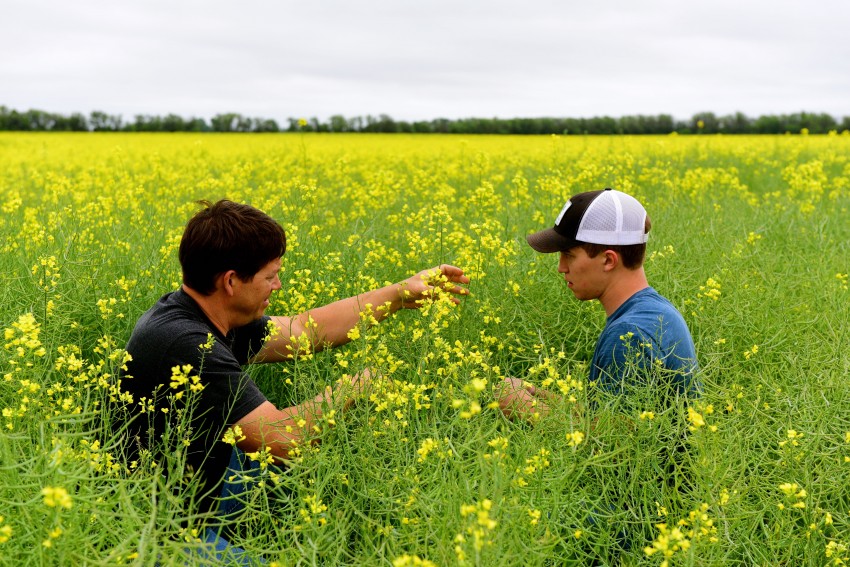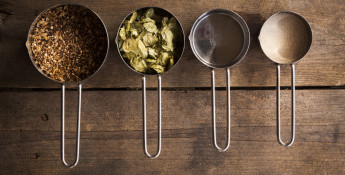By Rick McNary on June 28, 2017
Kansas Canola
This farm family took a chance growing canola

“What is that beautiful gold stuff in the field over there?” I asked my wife. “I’ve lived in Kansas all my life and have never seen a crop so vibrant and beautiful.”
We ran through the checklist of what crop it could be and finally settled on canola. I asked around to see who raises it and met the delightful farm family of Cameron, Jeanne, Connor and Hayden Peirce of Hutchinson.
“We are always looking for new crops to try out. I talked him into growing sunflowers a few years ago then I suggested canola,” Jeanne says. “Cameron comes from a long line of farmers who were pretty creative and willing to try new crops so we gave it a try.”
“Our first two years were kind of tough,” Cameron says. “But I wanted to grow canola because it’s a broadleaf plant, which means it will help clean a field of a lot of grass. When a good canola crop is on, it is so thick that not even deer can walk through it and grasses won’t grow. For our crop rotation, we plant wheat for two years then plant canola for one. I’ve been farming no-till for more than 20 years.
“The first time we harvested it with our regular combines was a real challenge,” Cameron says. “The seeds are so small they fall through the cracks like water. For example, one pound of milo (or grain sorghum) contains about 13,000 seeds. However, one pound of canola contains up to 100,000 seeds. The seeds are about one-third the size of a BB.”
Pollinators are critical to a canola crop’s success.
“Without bees, we couldn’t do what we do,” Cameron says. “There are a lot of beekeepers in the area which helps our crops. Sometimes, we even bring bees in to help us with our sunflowers or canola.”
Once the crop is harvested, it is sent to Goodland for processing into canola oil.
“The grain elevators and processing plants like canola because it hits at a different time than other crops. The seeds are so light and small that grain elevators have to take a few extra precautions to make sure they don’t literally fall through the cracks.
“We often cut it at night because we like a bit of moisture on it. If it becomes too dry, then it is harder to handle in our combines and at the grain elevator.”
Canola is a member of the same family as mustard, Brussels sprouts, cabbage and cauliflower. The origins of canola began with the rapeseed whose oil has a variety of uses ranging from cooking oils to lubricants. Although rapeseed oil had been used as cooking oil for centuries, many considered the high content – 30 to 60 percent – of erucic acid unhealthy.
In the ’60s, Canadian farmers began cross-breeding the plants and came up with a seed that was high in the good oleic acid and reduced the erucic acid to FDA-approved levels of 0.5 to 1 percent. In 1978, they christened it Canola – Canadian oil – to distance it from the negative connotation with the word, “rape.”
It is considered a heart-healthy food because it is low in saturated fats yet higher in monounsaturated fats as well as containing the polyunsaturated Omega-3 fatty acids.
According to the U.S. Canola Association, there are 1.7 million acres grown in the U.S. However, the demand is greater than the supply by a ratio of 1:4 so there is a need for increased production.
As one drives our Kansas roads, it is as if our farmers are artists who take large brushes and stroke the landscape with amber waves of wheat, burnt sienna rows of milo, cadmium yellow sunflower heads tracing the sun, emerald green leaves of the soybean plant and hunter green stalks of corn. Now our farming artists are adding swatches of yellow gold canola to delight our eyes and produce healthy food products for our consumption.
“One of the great aspects of growing canola is the way people respond to it,” Jeanne says. “People are astonished at the beauty of a field of flowering canola.”
Next year during the month of May, treat your visual senses to the beauty of this crop by traveling to various parts of the state where canola is grown. An easy way to find out where it is grown is to contact the Reno County Farm Bureau. Take your camera and if you happen to see a farmer near, stop and thank them for providing us not only the natural beauty of the crops they raise, but also healthy food products to feed our world.







